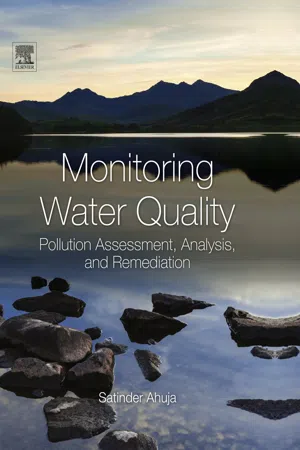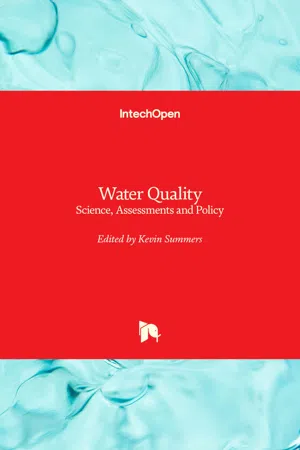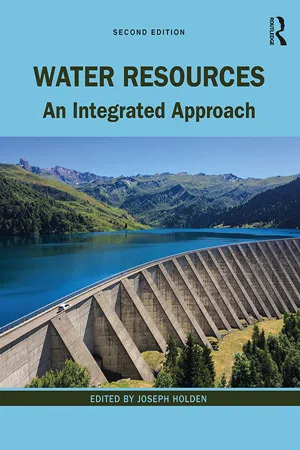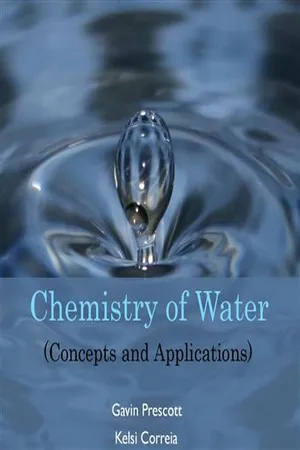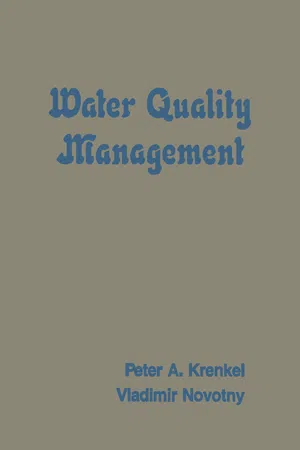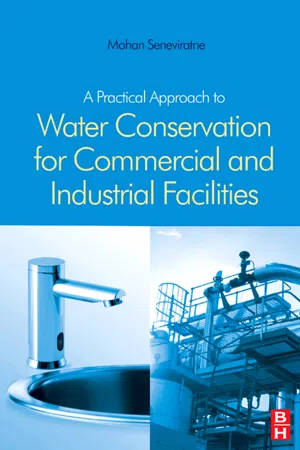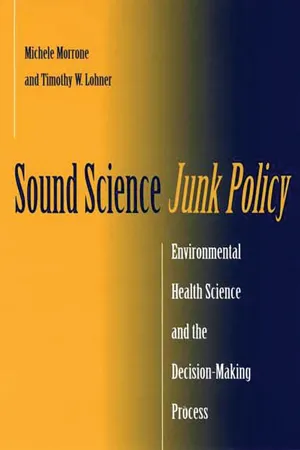Chemistry
Potable Water
Potable water refers to water that is safe for human consumption, meeting the standards for drinking. It is free from harmful contaminants and pathogens, making it suitable for drinking, cooking, and other domestic uses. In chemistry, the analysis of potable water involves testing for various chemical and physical parameters to ensure its quality and safety.
Written by Perlego with AI-assistance
Related key terms
1 of 5
8 Key excerpts on "Potable Water"
- eBook - ePub
Monitoring Water Quality
Pollution Assessment, Analysis, and Remediation
- Satinder Ahuja(Author)
- 2013(Publication Date)
- Elsevier(Publisher)
11 Potable WaterNature and Purification
Abul Hussam, CENTER FOR CLEAN WATER AND SUSTAINABLE TECHNOLOGIES, DEPARTMENT OF CHEMISTRY AND BIOCHEMISTRY, GEORGE MASON UNIVERSITY, FAIRFAX, VA, USAChapter Outline11.1 Introduction11.2 Water Pollution: Nature and Quality11.3 Chemical Models in Aquatic Chemistry11.3.1 Chemical Equilibrium Model: Surface-Complexation Reactions11.3.2 Continuous Proton-Binding Model and pK a -Spectrum11.3.3 Octanol–Water Partitioning Model and Bio-Concentration Factors (BCF)11.4 Development of Mitigation Technologies.11.4.1 Chemical Purification of Water: Chlorine and Derivatives11.4.2 Membrane Filtration Systems11.4.3 Development of Sorbent Based Water Filters11.4.3.1 Development of Iron Oxides and Iron Oxide–Amended Materials for Water Filters11.4.3.2 Nanoiron11.4.3.3 Modeling Sorption Breakthrough of Water Filters: Finite Element Analysis11.5 The Role of Analytical Chemistry11.6 Conclusions and Future OutlookReferences11.1 Introduction
Fresh water is the primary source of human health, prosperity, and security. By around 2050 the world’s population is expected to reach about nine billion. Assuming that standards of living continue to rise, the requirement of Potable Water for human consumption will amount to the resources of about three planet Earths [1] . A key United Nations report indicates that water shortages will affect 2.3 billion people or 30% of the world’s population in four dozen nations by 2025 [2] . Already, the crisis of Potable Water in most developing countries is creating public health emergencies of staggering proportions. In Bangladesh, for example, it is officially recognized by the government of Bangladesh that 50% of the country’s approximately 150 million people, are at risk of arsenic poisoning from groundwater used for drinking. Recently, the government of Bangladesh, in its Action Plan for Poverty Reduction , stated its desire to ensure 100% access to pure drinking water across the region within the shortest possible time frame [3] . This is also consistent with key goals of the Millennium Development Goal “Eradication of extreme poverty and hunger” and “Halving by 2015, the proportion of people without sustainable access to safe drinking water” [4] - eBook - PDF
Water Quality
Science, Assessments and Policy
- Kevin Summers(Author)
- 2020(Publication Date)
- IntechOpen(Publisher)
2. Classification of water Based on its source, water can be divided into ground water and surface water [5]. Both types of water can be exposed to contamination risks from agricultural, industrial, and domestic activities, which may include many types of pollutants such as heavy metals, pesticides, fertilizers, hazardous chemicals, and oils [6]. Water quality can be classified into four types—Potable Water, palatable water, contaminated (polluted) water, and infected water [7]. The most common scientific definitions of these types of water quality are as follows: 1. Potable Water: It is safe to drink, pleasant to taste, and usable for domestic purposes [1, 7]. Water Quality - Science, Assessments and Policy 4 2. Palatable water: It is esthetically pleasing; it considers the presence of chemi-cals that do not cause a threat to human health [7]. 3. Contaminated ( polluted) water: It is that water containing unwanted physical, chemical, biological, or radiological substances, and it is unfit for drinking or domestic use [7]. 4. Infected water: It is contaminated with pathogenic organism [7]. 3. Parameters of water quality There are three types of water quality parameters physical, chemical, and biological [8, 9]. They are summarized in Table 1 . 3.1 Physical parameters of water quality 3.1.1 Turbidity Turbidity is the cloudiness of water [10]. It is a measure of the ability of light to pass through water. It is caused by suspended material such as clay, silt, organic material, plankton, and other particulate materials in water [2]. - No longer available |Learn more
- (Author)
- 2014(Publication Date)
- Academic Studio(Publisher)
________________________ WORLD TECHNOLOGIES ________________________ Chapter- 7 Water Purification Water purification is a process of removing undesirable chemicals, materials, and biological contaminants from contaminated water. The goal is to produce water fit for a specific purpose. Most water is purified for human consumption (drinking water) but water purification may also be designed for a variety of other purposes, including meeting the requirements of medical, pharmacology, chemical and industrial applications. In general the methods used include physical processes such as filtration and sedimentation, biological processes such as slow sand filters or activated sludge, chemical processes such as flocculation and chlorination and the use of electromagnetic radiation such as ultraviolet light. The purification process of water may reduce the concentration of particulate matter including suspended particles, parasites, bacteria, algae, viruses, fungi; and a range of dissolved and particulate material derived from the surfaces that water may have made contact with after falling as rain. The standards for drinking water quality are typically set by governments or by international standards. These standards will typically set minimum and maximum concentrations of contaminants for the use that is to be made of the water. It is not possible to tell whether water is of an appropriate quality by visual examination. Simple procedures such as boiling or the use of a household activated carbon filter are not sufficient for treating all the possible contaminants that may be present in water from an unknown source. Even natural spring water – considered safe for all practical purposes in the 1800s – must now be tested before determining what kind of treatment, if any, is needed. Chemical analysis, while expensive, is the only way to obtain the information necessary for deciding on the appropriate method of purification. - eBook - ePub
Water Resources
An Integrated Approach
- Joseph Holden(Author)
- 2019(Publication Date)
- Routledge(Publisher)
CHAPTER EIGHTPotable Water and wastewater treatment
Nigel J. HoranLearning outcomes After reading this chapter you should be able to:- understand the requirements for Potable Water quality standards in order to ensure water is safe and wholesome;
- explain how Potable Water is produced to meet these standards, through a series of individual treatment stages;
- describe the desalination processes used to produce Potable Water from saline or brackish sources;
- recognise major pollutants present in wastewater and their contribution to aquatic pollution;
- understand the importance of legally enforced standards in achieving improvements to aquatic waters;
- appreciate our changing attitudes that view wastewater (and indeed all wastes) as a resource to be recovered and recycled and be aware of some of the technical advances in this area;
- understand how wastewater treatment technologies are now driven by energy saving, greenhouse gas reduction and resource recovery measures, as well as meeting legally enforced discharge standards;
- recognise those situations when a number of small, decentralised treatment systems might be more appropriate than a single, large centralised system.
8.1 Introduction
Previous chapters have identified the major sources of Potable Water , namely surface waters (rivers and lakes), groundwater (including springs) or engineered storage reservoirs and dams. Ensuring an adequate supply of water that will serve the population and which will not run out during times of drought is a basic necessity. But, in addition to adequacy, the water supplied must be clean, wholesome and palatable in order to protect the health of the consumer. Achieving this requires treatment, and the nature of the treatment is a function of the quality of the source water. Whereas groundwaters are relatively clean and need fewer treatment steps, surface waters are open to direct environmental input and so multiple treatment stages are generally needed to achieve the required water quality. In addition to the supply of safe drinking water there is the need to deal with wastewater. Wherever human populations settle, whether in villages, towns or cities, they are faced with the problem of disposing of their excreta in a safe manner. As populations have traditionally developed close to a source of Potable Water (typically a river or lake), this has usually been the first point of disposal. But as populations have increased this route has become increasingly polluted. The history of sanitary engineering is therefore the history of our attempts to remove waste from its point of origin and dispose of it safely, with minimal impact on the environment. This chapter deals with the steps taken to treat water so that it is safe to drink and then examines the principles of wastewater treatment and how we go about producing effluent that has a minimal impact on the aquatic environment. As discussed in Chapter 7 , in the mid-nineteenth century, Dr John Snow was able to show that an epidemic of cholera in London was a result of a contaminated water supply, even though the causative agent of cholera itself (Vibrio cholerae ) had not been discovered. By the beginning of the twentieth century, filtration of water followed by chlorination was widely practised in Europe and North America to ensure complete removal of pathogenic - No longer available |Learn more
- (Author)
- 2014(Publication Date)
- Academic Studio(Publisher)
________________________ WORLD TECHNOLOGIES ________________________ Chapter 10 Water Purification Water purification is a process of removing undesirable chemicals, materials, and biological contaminants from contaminated water. The goal is to produce water fit for a specific purpose. Most water is purified for human consumption (drinking water) but water purification may also be designed for a variety of other purposes, including meeting the requirements of medical, pharmacology, chemical and industrial appli-cations. In general the methods used include physical processes such as filtration and sedimentation, biological processes such as slow sand filters or activated sludge, che-mical processes such as flocculation and chlorination and the use of electromagnetic radiation such as ultraviolet light. The purification process of water may reduce the concentration of particulate matter including suspended particles, parasites, bacteria, algae, viruses, fungi; and a range of dissolved and particulate material derived from the surfaces that water may have made contact with after falling as rain. The standards for drinking water quality are typically set by governments or by international standards. These standards will typically set minimum and maximum conc-entrations of contaminants for the use that is to be made of the water. It is not possible to tell whether water is of an appropriate quality by visual examination. Simple procedures such as boiling or the use of a household activated carbon filter are not sufficient for treating all the possible contaminants that may be present in water from an unknown source. Even natural spring water – considered safe for all practical purposes in the 1800s – must now be tested before determining what kind of treatment, if any, is needed. Chemical analysis, while expensive, is the only way to obtain the information necessary for deciding on the appropriate method of purification. - eBook - PDF
- Peter Krenkel(Author)
- 2012(Publication Date)
- Academic Press(Publisher)
3 Physical and Chemical Parameters of Water Quality INTRODUCTION The term water quality is not a new concept. Ancient British Common Law, from which the riparian water rights were derived, stated that the user of water was not entitled to diminish it in quality (McGauhey, 1968). However, the question as to what constituted quality was neither posed nor answered. Even at the beginning of this century, water quality evaluation relied more or less on subjective observations rather than on scientific measurements. Water quality was expressed in terms such as fresh, dirty, faulty, and potable. Only water used for a public water supply was analyzed by early chemical and bacte-riological methods in order to determine its safety for human consump-tion. Recent developments in water quality surveillance methods and con-sequent concern with the protection of human health and the aquatic envi-ronment have broadened the qualification and quantification of water quality. It has been only in the past few decades that water quality engineering and science have begun to develop from an art to a science. New wastewater treatment methods and the discovery and evaluation of new harmful water contaminants and pollutants have stimulated research 46 Classification of Pollutants 47 activities seeking new and improved methods of water quality analysis. Increased emphasis has also been placed on the removal of secondary pollutants such as nutrients or refractory organics and on water reuse. There is no way to define water quality precisely. It must be understood that the quantification of water quality may have a different meaning to an aquatic scientist concerned with aquatic life, a farmer concerned with irri-gation, or a public health official concerned with the protection of human health. In each case, a different picture of water quality can be developed based on the indicators and criteria used for a particular evaluation. - Mohan Seneviratne(Author)
- 2007(Publication Date)
- Elsevier Science(Publisher)
Chapter 2 Basic Water Chemistry 2.1 Overview Before we delve into water conservation, it is useful to have an understanding of the basic concepts in water chemistry and ions commonly found in water. Water is known as the universal solvent due to its power to dissolve virtually all substances to some extent. The key to this phenomenal ability is its structure . The water molecule consists of two atoms of hydrogen and one atom of oxygen with a slight positive charge near the hydrogen atoms and a slight negative charge near the oxygen atom. This polarity enables the water to dissolve all ionic and polar substances. Non-polar compounds such as hydrocarbons are insoluble in water. For this reason pure water is not found in nature. It always contains impurities, which impart colour, clarity, taste, smell and feel. The types of impurities found in water and wastewater can be divided into four groups: dissolved, physical, microbial and radiological (Table 2.1). Impurities in natural waters depend on the source of water. Wells and spring waters are classed as ground water while rivers and lakes are known as surface waters . Ground water picks up impurities as it seeps through the rock strata, dissolving some parts of (or almost all) it makes contacts with. However, the natural filtering effect of rock and sand usually keeps water free of suspended matter. Wastewater may contain a myriad of substances depending on the source and can range from inorganic to organic substances. For example, effluent from food processes have high levels of organic matter, and leachate from landfills contains organic substances, ammonia as well as heavy metals. Solubility principles, some common substances found in commercial and industrial water systems, and water-quality guidelines are discussed below. It is by no means a complete list; however, it gives the reader an appreciation for the types of contaminants and their impacts on water systems.- eBook - PDF
Sound Science, Junk Policy
Environmental Health Science and the Decision-Making Process
- Michele Morrone, Timothy W. Lohner(Authors)
- 2002(Publication Date)
- Praeger(Publisher)
Both bottled water and tap water contain minerals, but at inconsistent levels de- pending on the source, so it is important for consumers to be aware of their min- eral needs and the mineral content of their drinking water source in order to make sound drinking water choices. 4 The government focuses a substantial amount of resources to ensure that the 170,000 public water systems in the United States produce safe and palatable water. Regulations pertaining to both biological and chemical substances in 118 Sound Science, Junk Policy drinking water cost citizens millions of dollars per year. One major policy issue with regard to drinking water is the use of science to set appropriate limits for contaminants. Setting contaminant levels can be controversial considering the scientific uncertainties involved in estimating the health risks of lifetime expo- sures at relatively unknown doses. Furthermore, as with many other environ- mental health issues, there are some substances in drinking water for which the risks are known and others for which the risks are unknown. The health effects of microbiological contaminants are well established, while those of chemical contaminants are still under study. Many environmental health professionals believe that microbiological con- taminants are the greatest threat to the public's water supply. As discussed later, incidents such as a 1993 Cryptosporidium outbreak in Milwaukee in which more than 400,000 people became acutely ill reinforce the concerns of these profes- sionals. There is abundant science describing the human health effects of micro- biological contaminants in drinking water. We know that some microbiological contaminants can survive the chlorination process, and we know what the health effects of ingesting these contaminants are. We also know that since the devel- opment and implementation of modern drinking water treatment processes, there has been a dramatic decrease in disease outbreaks.
Index pages curate the most relevant extracts from our library of academic textbooks. They’ve been created using an in-house natural language model (NLM), each adding context and meaning to key research topics.
